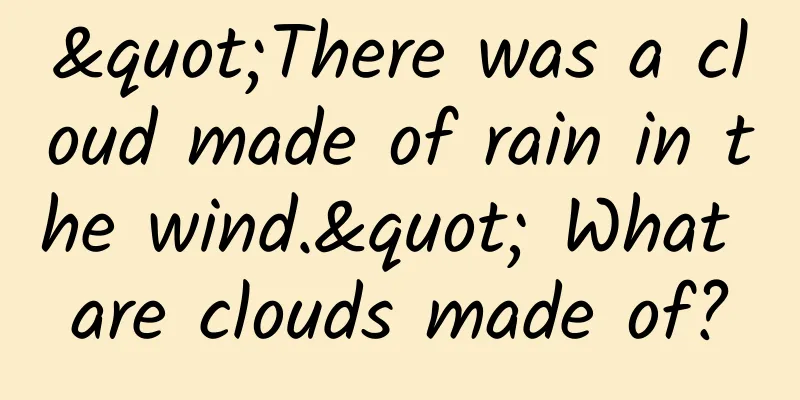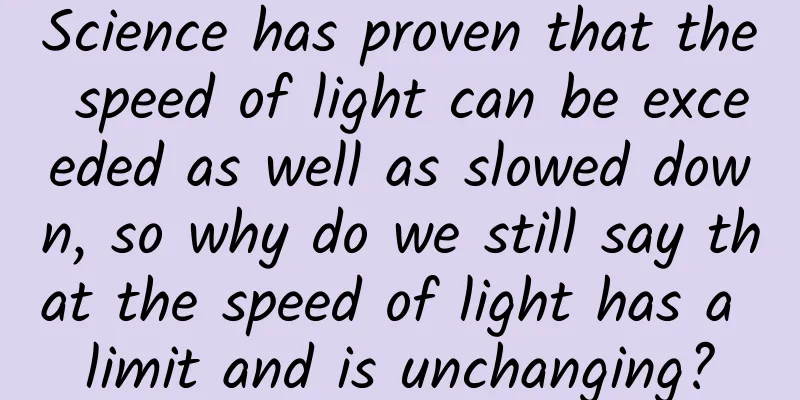"There was a cloud made of rain in the wind." What are clouds made of?

|
Produced by: Science Popularization China Author: Meteorological Science Team Producer: China Science Expo Everyone may have had this experience: when the cloud cover in the sky increases and the cloud level decreases, the weather may turn bad; conversely, when the cloud cover decreases and the cloud level increases, it may be a sign of improving weather. So, do you know how clouds are formed? What kind of weather process will be predicted by the various shapes of clouds in the sky? Let's uncover these secrets together! Cloud (Photo source: veer photo gallery) 1. Causes and Composition of Clouds The formation of clouds is mainly caused by the condensation of water vapor. We all know that in the layer of atmosphere more than ten kilometers above the ground, the closer to the ground, the higher the temperature and the denser the air; the higher into the sky, the lower the temperature and the thinner the air. On the other hand, the water surface of rivers, lakes and seas, as well as the moisture in the soil and animals and plants, evaporates into the air at any time and becomes water vapor. After the water vapor enters the atmosphere, it forms clouds and causes rain, or condenses into frost and dew, and then returns to the ground, seeps into the soil or flows into rivers, lakes and seas. Later, it evaporates again (sublimates), and then condenses (de-sublimates) and falls. The cycle repeats itself endlessly. When water vapor enters the lower atmosphere from the evaporation surface, the temperature here is high and it contains more water vapor. If this hot and humid air is lifted, the temperature will gradually decrease. At a certain height, the water vapor in the air will reach saturation. If the air continues to be lifted, excess water vapor will precipitate. If the temperature there is higher than 0°C, the excess water vapor will condense into small water droplets; if the temperature is lower than 0°C, the excess water vapor will condense into small ice crystals. When these small water droplets and small ice crystals gradually increase and reach a level that can be recognized by the human eye, it becomes a cloud. 2. How to classify different clouds? Now we know that clouds are mainly formed by the adiabatic cooling of rising air, which is a common feature of cloud formation. But in addition to this, the clouds in the sky always have different shapes and are ever-changing. Why is this? Generally speaking, this is because water vapor has different characteristics in the condensation or sublimation process, thus forming different cloud shapes. This is the personality of different cloud formations. According to the height of the cloud base, clouds can be divided into three major cloud families: high clouds, middle clouds, and low clouds. Then, according to the appearance, structure, and causes of clouds, they can be divided into ten genera and twenty-nine categories, which are mainly: 1. Low Clouds There are five categories (types) of clouds: stratocumulus, stratus, nimbostratus, cumulus, and cumulonimbus. Among them, stratus, stratus, and nimbostratus are composed of water droplets, and the cloud base height is usually below 2,500 meters. Most low clouds may rain, and nimbostratus often have continuous rain and snow. Cumulus and cumulonimbus clouds are composed of a mixture of water droplets, supercooled water droplets, and ice crystals. The cloud base height is usually below 2,500 meters, but the cloud top is very high. Cumulonimbus clouds often have thunderstorms, sometimes accompanied by strong winds and hail. Stratocumulus clouds (Image source: veer photo gallery) 2. Zhongyun There are two types of clouds: high-level clouds and altocumulus clouds. They are mostly composed of water droplets, supercooled water droplets and ice crystals. The cloud base is usually between 2500 and 5000 meters. High-level clouds often produce rain and snow, but thin altocumulus clouds generally do not rain. 3. Gao Yun There are three categories of clouds: cirrus, cirrostratus and cirrocumulus, all of which are composed of small ice crystals, with the cloud base usually above 5,000 meters. High clouds generally do not rain, but cirrostratus and cirrocumulus clouds in the north may occasionally snow in winter. 3. Look at the clouds to know the weather Long-term observations and practice have shown that the formation and dissipation of clouds, as well as the evolution and transformation of various types of clouds, all take place under certain conditions of water vapor and atmospheric movement. People cannot see water vapor or atmospheric movement, but they can see the movements of water vapor and atmospheric movement from the formation and dissipation of clouds. Water vapor and atmospheric movement play an extremely important role in weather phenomena such as rain, snow, ice, and hail. For thousands of years, my country's working people have summed up rich experience in "observing clouds and knowing the weather" based on changes in the shape, direction, speed, thickness, color, etc. of clouds in production practice, and compiled these experiences into proverbs. Here we list a few proverbs about "knowing the weather by looking at the clouds". Friends who are interested may wish to pay attention to them and make some observations and comparisons when "appreciating the clouds". "When clouds meet, it will rain heavily": When clouds meet, it means that the moving directions of upper and lower clouds are inconsistent, that is, the wind directions at the heights of the clouds are inconsistent. This often happens near the front or low pressure, so it indicates that it will rain. Sometimes, when the clouds are in the opposite direction of the wind on the ground, there is a saying that "When clouds move against the wind, the weather is going to change." “Cotton clouds mean rain is coming soon”: Cotton clouds refer to flocculent altocumulus clouds. The appearance of such clouds indicates that the middle atmosphere is very unstable. If there is sufficient water vapor in the air and there is an upward movement, cumulonimbus clouds will form and thunderstorms will come. Cotton Cloud (Photo source: veer Gallery) “Fish-scale sky, no rain but strong winds": Fish-scale sky refers to cumulus clouds. The appearance of such clouds indicates that the upper atmosphere is unstable. If the clouds continue to lower and thicken, it means that the area is in front of a low-pressure trough and it will soon rain or be windy. “Don't go out if there is morning glow, but travel a thousand miles if there is evening glow”: In the morning, there are no clouds in the east but there are clouds in the west. The sunlight shines on the clouds and scatters colorful clouds. This shows that there is abundant moisture in the air or a rainy system is moving in. Plus, the air is generally unstable during the day, so the weather will turn to cloudy and rainy. If there are evening glows in the evening, it means that the western sky has cleared up. Plus, convection generally weakens at night, so the eastern clouds that formed the colorful clouds will move further east or tend to dissipate, which means that the sky will be clear. In addition, there are many proverbs that predict hail from the color and shape of clouds. For example, there are proverbs in Inner Mongolia such as "I am not afraid of black clouds, but I am afraid of black clouds with red, and I am most afraid of white worms growing under yellow clouds", and there are proverbs in Shanxi such as "Yellow clouds turn over, hail will fall; clouds are stirred up randomly, hail will come in groups; clouds fight, hail will fall", "Black clouds, yellow clouds, and red clouds, stirring up clouds repeatedly, there are often serious hail disasters", etc. These proverbs all indicate that when air convection is strong, clouds develop rapidly, rushing up like thick smoke, and clouds roll up and down, back and forth, it is easy to hail. There is much more to learn about the cloud than what is listed above. If you are interested, you may wish to observe and record more to learn! |
<<: Air conditioning was invented to "save you"? Wrong! The truth is...
>>: What harm will excessive plant growth and high oxygen concentration cause to other organisms?
Recommend
To Wang Xuehong: The best apology to shareholders is to sell HTC
Recently, HTC CEO Wang Xuehong bowed and apologiz...
We published an article in Physics Today, revealing another Nobel Prize-winning contribution of Wu Jianxiong that was buried
From the meeting at Yang Zhenning's home in 2...
Effective techniques to increase followers through Baidu promotion! Replicable practical cases!
In the cold winter of the Internet, many friends ...
Appointment with the Starry Sky丨Look! The "Chinese Star" is shining in the sky
(This article is reproduced from Xinhua News Agen...
World Migratory Bird Day丨As a migratory bird that is almost "forgotten", why is the migration route of the relict gull so different?
Produced by: Science Popularization China Author:...
The development of autonomous driving is accelerating, and test cars will be on the highway next year
At the end of 2017, Beijing was the first city to...
Today is the Winter Solstice | Should we eat dumplings or glutinous rice balls?
In your hometown Should we eat dumplings or gluti...
Two species of gibbons have become extinct in the wild in my country. Can they come back?
On September 6, at the annual working meeting of ...
Feng Qingyang Stock Market Practice Course 2
Resource introduction of Feng Qingyang's 2nd p...
Dr. Mo reviews iPhone 6S: The best smartphone ever
Apple has just released its new smartphone, iPhon...
Can tea be used for latte art? What kind of art is the "tea art" in "Dream of the Red Chamber"?
Audit expert: Liu Jun College of Food Science and...
What happened in the past two years when Twitter’s stock price was halved and Weibo’s stock price doubled?
Twitter is in dire straits, while the latest fina...
Hunter Camp - Ni Yeming "Official Account SEO Money-Making Special Training Course" WeChat Search Ranking Optimization
Hunter Camp - Ni Yeming's "Special Train...
Fan Jian's "Latest Taobao Tmall Courses" series of tutorials to increase conversion rate by at least 200% (Advanced)
Course Contents: Lesson 1: Completely restore the...
Xiaohongshu product analysis report!
Xiaohongshu is known as a popular shopping tool f...









